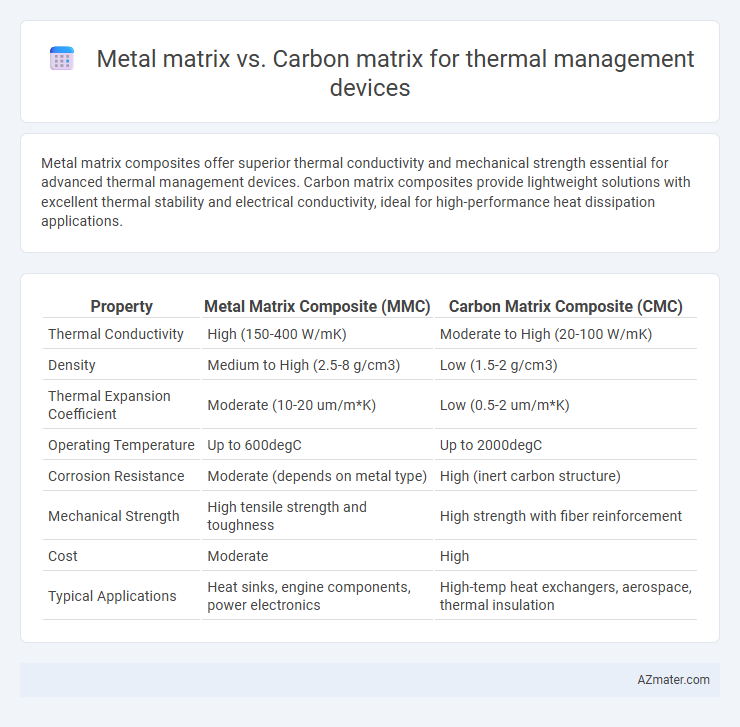Metal matrix composites offer superior thermal conductivity and mechanical strength essential for advanced thermal management devices. Carbon matrix composites provide lightweight solutions with excellent thermal stability and electrical conductivity, ideal for high-performance heat dissipation applications.
Table of Comparison
| Property | Metal Matrix Composite (MMC) | Carbon Matrix Composite (CMC) |
|---|---|---|
| Thermal Conductivity | High (150-400 W/mK) | Moderate to High (20-100 W/mK) |
| Density | Medium to High (2.5-8 g/cm3) | Low (1.5-2 g/cm3) |
| Thermal Expansion Coefficient | Moderate (10-20 um/m*K) | Low (0.5-2 um/m*K) |
| Operating Temperature | Up to 600degC | Up to 2000degC |
| Corrosion Resistance | Moderate (depends on metal type) | High (inert carbon structure) |
| Mechanical Strength | High tensile strength and toughness | High strength with fiber reinforcement |
| Cost | Moderate | High |
| Typical Applications | Heat sinks, engine components, power electronics | High-temp heat exchangers, aerospace, thermal insulation |
Introduction to Thermal Management Devices
Thermal management devices rely on materials with high thermal conductivity to efficiently dissipate heat from electronic components, where metal matrix composites (MMCs) exhibit superior thermal performance due to metals like aluminum or copper embedded with ceramic particles. Carbon matrices, especially those utilizing graphite or carbon fibers, offer exceptional thermal conductivity combined with lightweight properties but may face challenges in mechanical robustness and integration. Selecting between metal matrix and carbon matrix materials depends on balancing thermal conductivity, mechanical strength, and weight requirements critical for advanced thermal management applications.
Overview of Metal Matrix Materials
Metal matrix materials, commonly composed of aluminum, copper, or their alloys, offer superior thermal conductivity ranging from 150 to 400 W/m*K, making them ideal for efficient heat dissipation in thermal management devices. These materials exhibit excellent mechanical strength, thermal stability, and good corrosion resistance, ensuring reliable performance in demanding environments. The high thermal conductivity combined with favorable mechanical properties positions metal matrix composites as a preferred choice for cooling applications in electronics and automotive industries.
Overview of Carbon Matrix Materials
Carbon matrix materials offer exceptional thermal conductivity and lightweight properties essential for advanced thermal management devices used in aerospace and electronics cooling. Their intrinsic low density combined with high-temperature stability enables efficient heat dissipation while maintaining structural integrity under thermal stress. Advanced carbon composites, including carbon fiber-reinforced matrices, excel in tailored thermal expansion coefficients and superior fatigue resistance compared to traditional metal matrices.
Thermal Conductivity Comparison: Metal vs Carbon Matrices
Metal matrices typically exhibit higher thermal conductivity compared to carbon matrices due to the metallic bonding and free electron movement facilitating efficient heat transfer. Carbon matrices, especially those based on graphite or graphene, can achieve high in-plane thermal conductivity but often suffer from anisotropy and lower through-thickness conductivity. Selecting between metal and carbon matrices for thermal management devices depends on the directional heat dissipation requirements and operating environment, with metals preferred for isotropic conduction and carbons for lightweight, high in-plane heat spreading.
Mechanical Properties and Structural Integrity
Metal matrix composites (MMCs) exhibit superior mechanical properties and structural integrity compared to carbon matrix composites (CMCs) due to their enhanced toughness, higher tensile strength, and better impact resistance, making them ideal for thermal management devices exposed to mechanical stresses. MMCs provide improved thermal conductivity along with excellent dimensional stability at elevated temperatures, while CMCs, despite their high-temperature capabilities, often suffer from brittleness and lower fracture toughness. The choice between metal and carbon matrices hinges on balancing the need for mechanical durability against thermal performance in harsh operational environments.
Weight and Density Considerations
Metal matrix materials typically offer higher thermal conductivity but come with increased weight and density, which can impact the overall efficiency and portability of thermal management devices. Carbon matrix composites are significantly lighter and possess lower density, enhancing device performance in weight-sensitive applications while maintaining adequate thermal dissipation. Selecting between metal and carbon matrices involves balancing the thermal conductivity benefits of metals against the lightweight and lower density advantages of carbon-based materials.
Corrosion Resistance and Durability
Metal matrix composites exhibit superior corrosion resistance in thermal management devices due to the inherent protective oxide layers formed on metals such as aluminum and copper, enhancing longevity in harsh environments. Carbon matrix composites, while offering excellent thermal conductivity, often require surface treatments or coatings to mitigate oxidation and corrosion, which can impact durability over time. The choice between metal and carbon matrices hinges on balancing corrosion resistance and mechanical lifespan based on specific operational conditions.
Manufacturing Processes and Scalability
Metal matrix composites offer superior thermal conductivity and mechanical strength, making them ideal for high-performance thermal management devices, with manufacturing processes such as powder metallurgy and infiltration enabling scalable production. Carbon matrix composites provide excellent thermal stability and lightweight properties, produced through methods like chemical vapor infiltration and resin impregnation, though these techniques can present challenges in scaling due to longer processing times and equipment complexity. Both materials require tailored fabrication strategies to balance cost, performance, and scalability in industrial applications.
Cost Analysis: Metal Matrix vs Carbon Matrix
Metal matrix materials typically offer lower production costs compared to carbon matrix composites due to established manufacturing techniques and readily available raw materials. Carbon matrix composites, while providing superior thermal conductivity and lightweight properties, involve higher costs linked to complex fabrication processes and expensive precursor materials. Cost analysis must balance initial expenditures with performance benefits, where metal matrices are preferred for budget-sensitive applications and carbon matrices for high-performance thermal management devices.
Applications and Future Trends in Thermal Management
Metal matrix composites excel in thermal management applications requiring high thermal conductivity and mechanical strength, such as heat sinks and power electronics cooling, due to metals like aluminum and copper. Carbon matrix composites, incorporating graphene or carbon fibers, offer superior thermal conductivity combined with lightweight properties, making them ideal for aerospace and automotive electronics cooling solutions. Emerging trends emphasize hybrid composites integrating metal and carbon matrices to optimize thermal performance, weight reduction, and manufacturability for next-generation thermal management devices.

Infographic: Metal matrix vs Carbon matrix for Thermal management device
 azmater.com
azmater.com